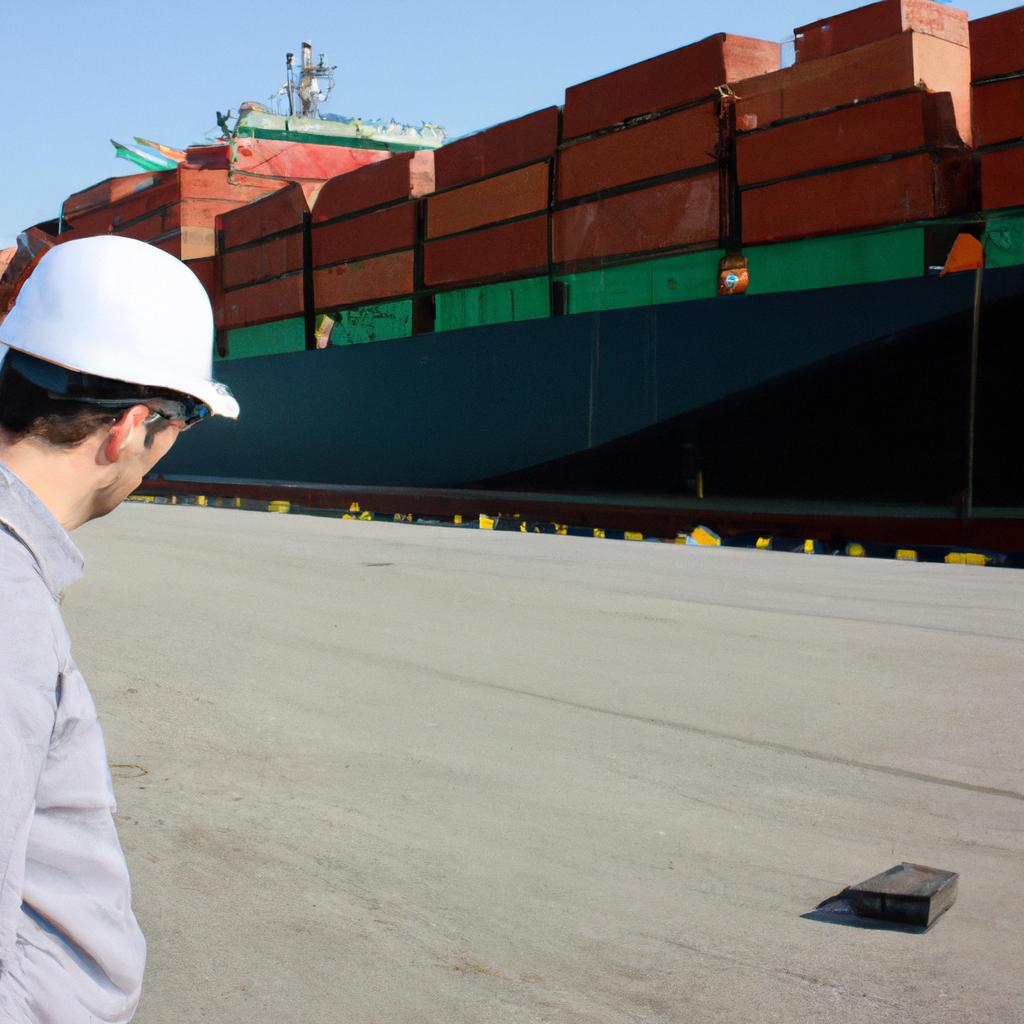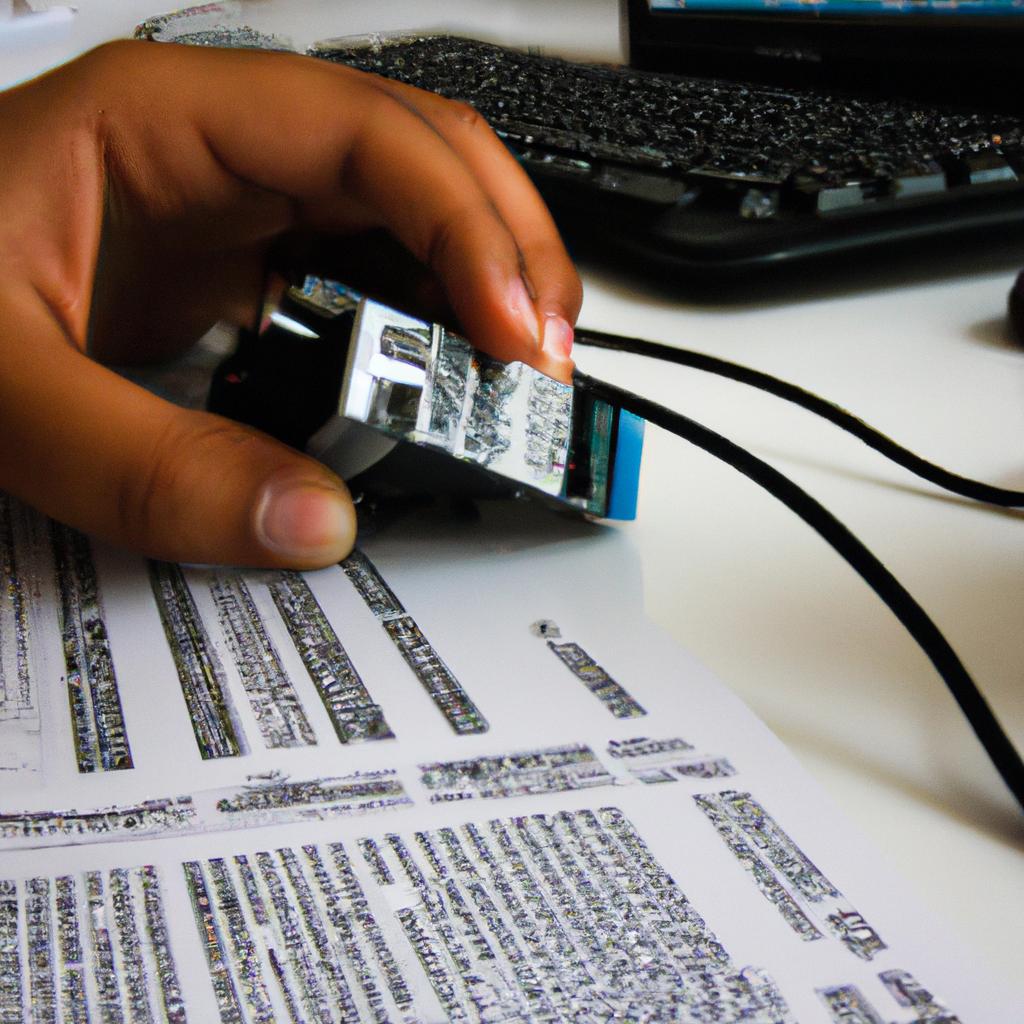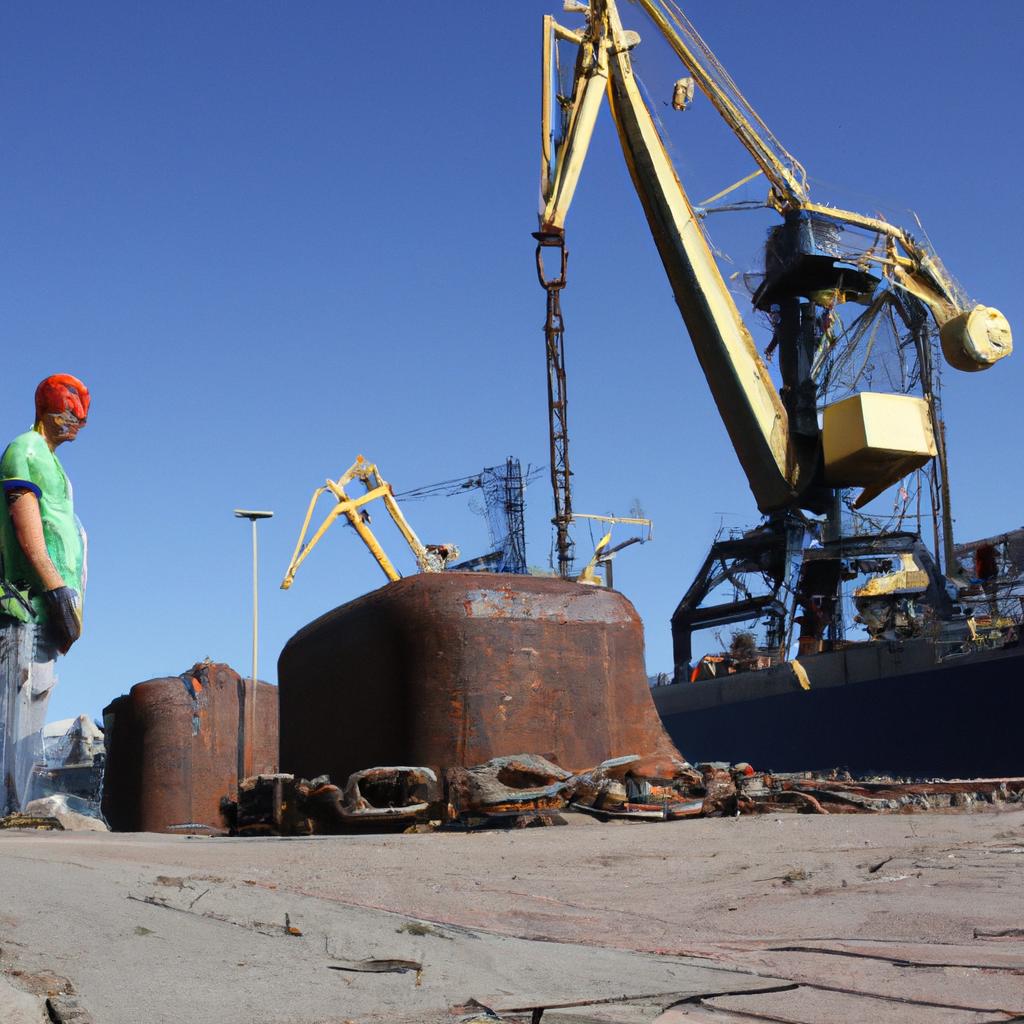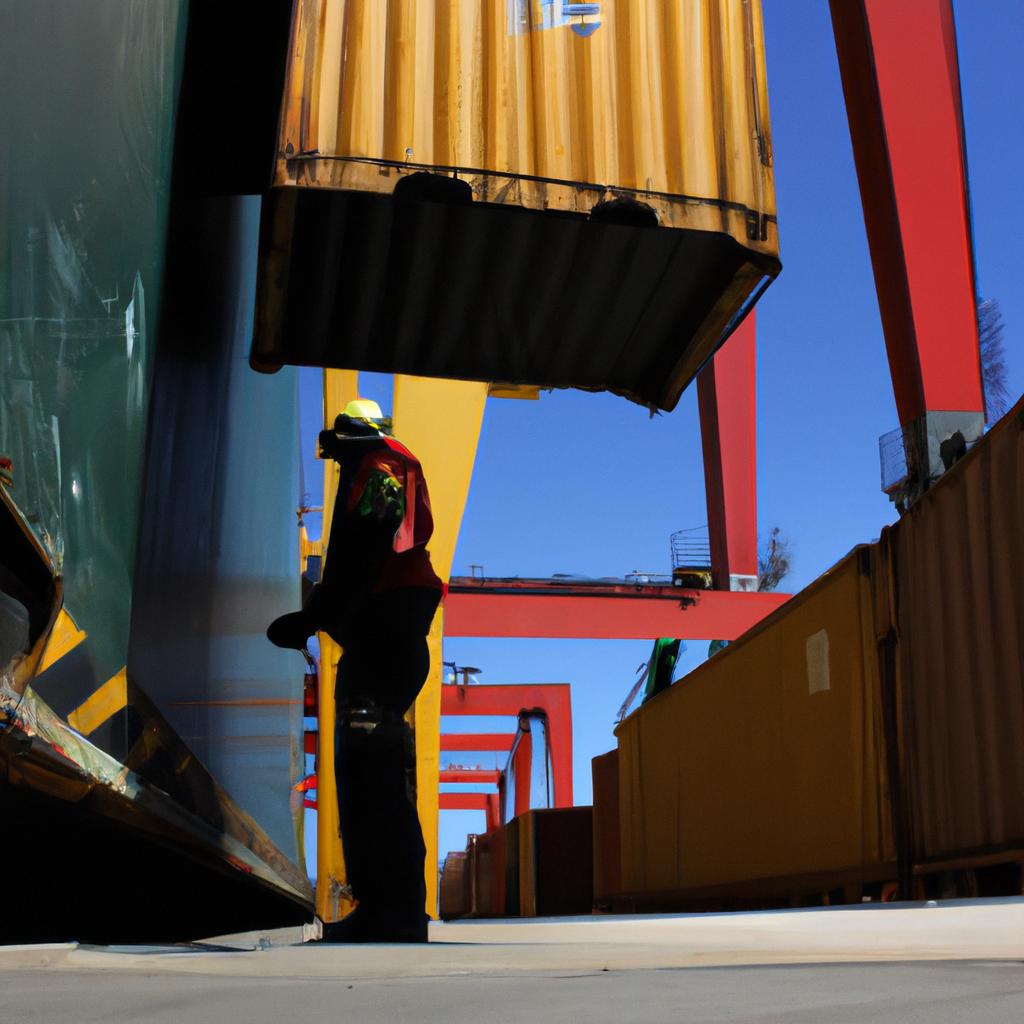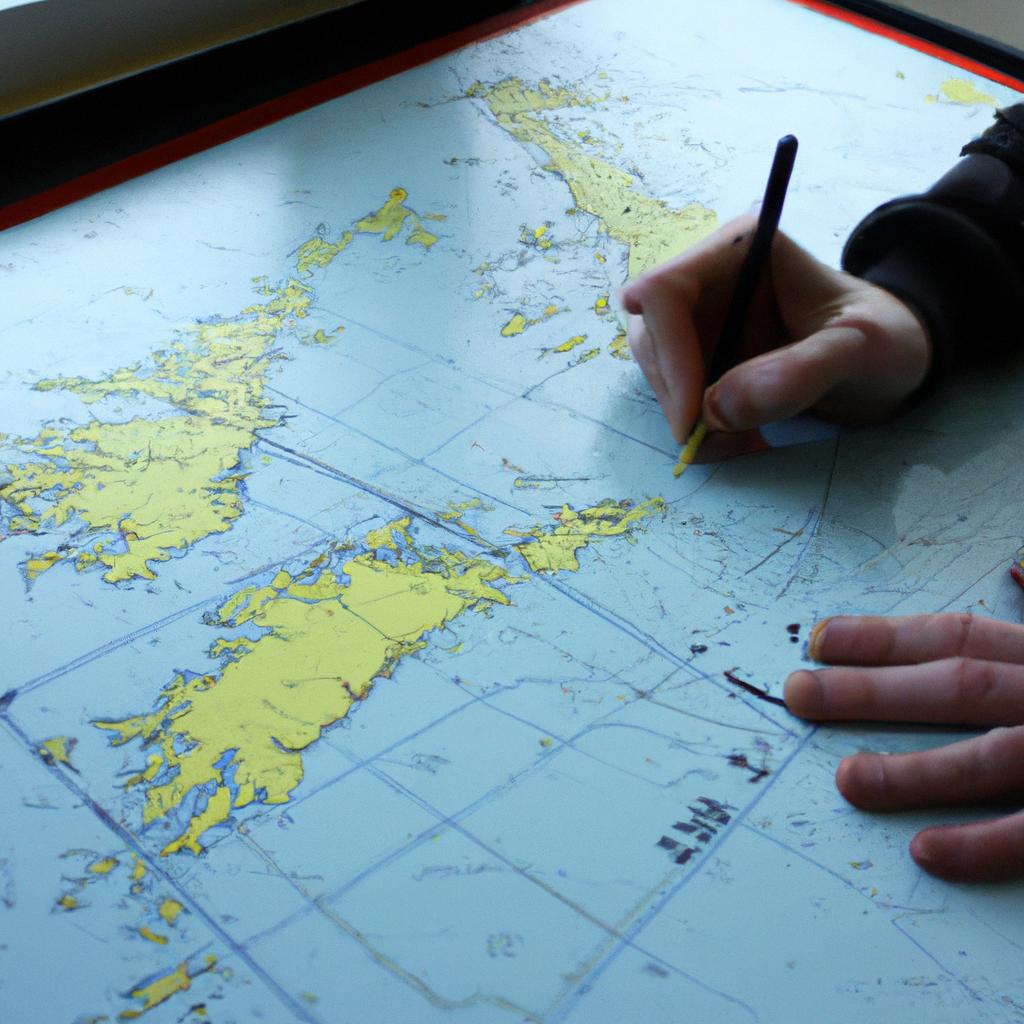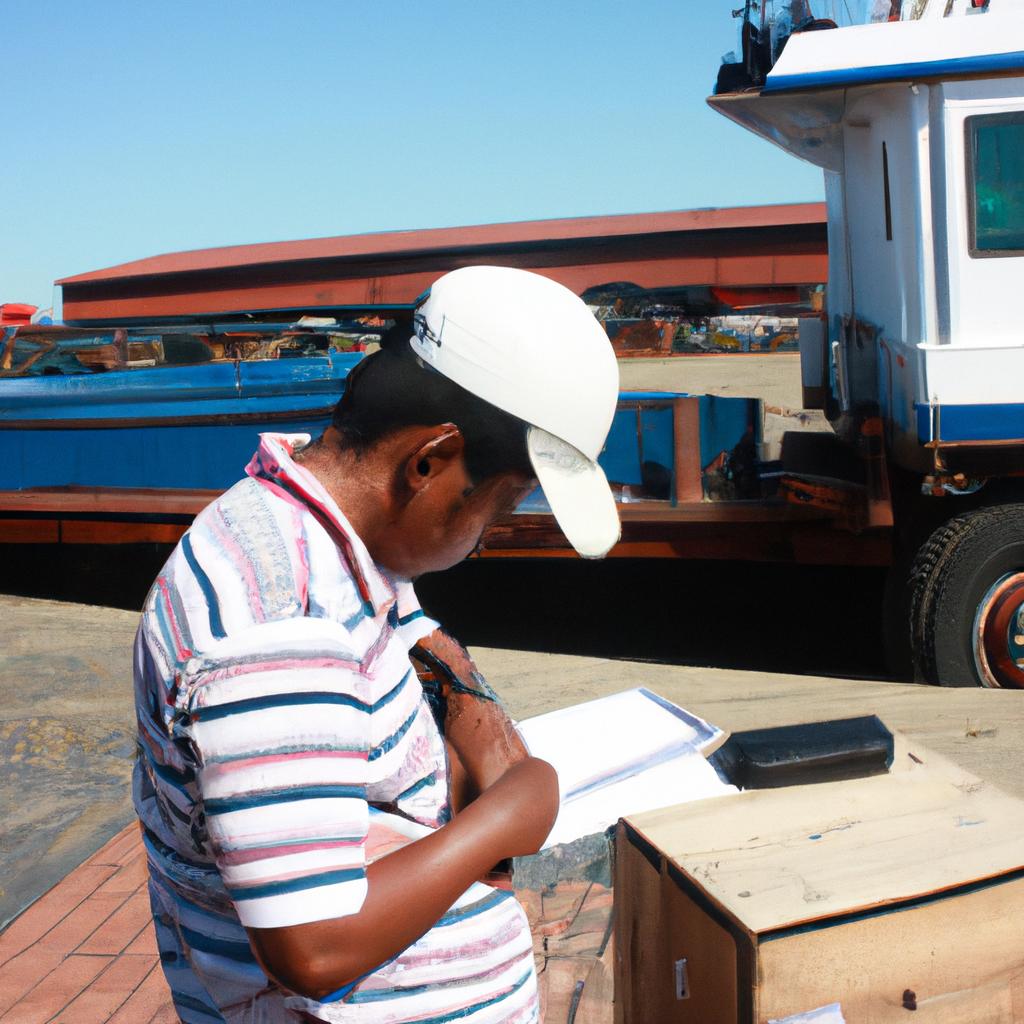Port security is a critical aspect of ensuring the smooth and secure flow of goods and people within the Black Sea region. With its strategic location connecting Europe, Asia, and the Middle East, this body of water has become a vital pathway for international trade and transportation. However, it also presents unique challenges in terms of maritime security due to its proximity to conflict zones and potential threats from piracy and terrorism. To illustrate these concerns, let us consider the hypothetical scenario of an unauthorized vessel attempting to smuggle illegal weapons through one of the major ports in the Black Sea.
In recent years, there have been increasing incidents related to port security breaches in the Black Sea region. This raises concerns about the vulnerability of ports in this area and highlights the need for comprehensive strategies and measures to ensure safe and secure operations. For instance, imagine a situation where an unidentified ship arrives at a busy port without proper documentation or inspection procedures. It can potentially carry dangerous cargo such as illicit drugs or even explosives that could pose significant risks not only to the port but also to nearby communities and national security interests. Therefore, addressing port security issues becomes imperative for safeguarding regional stability and maintaining efficient transport networks across the Black Sea region.
Current Threats to Port Security in the Black Sea Region
To understand the current threats to port security in the Black Sea region, it is essential to examine a relevant case study. Let us consider the hypothetical scenario of an unidentified vessel entering a major port without proper authorization or inspection. This incident highlights just one example of the potential dangers that can compromise port security in this important maritime area.
One significant threat facing ports in the Black Sea region is smuggling activities. Criminal organizations exploit vulnerabilities in port security systems to transport illegal goods across international borders. These include narcotics, weapons, and counterfeit products, which not only pose risks to national security but also have severe socio-economic implications for affected countries.
Moreover, terrorist attacks targeting ports are another grave concern in the Black Sea region. Terrorist groups may attempt to disrupt trade routes by attacking vessels or infrastructure within ports. The consequences of such incidents could be catastrophic, leading to loss of life, economic instability, and damage to global supply chains.
Additionally, cyberattacks on port systems and networks have emerged as a modern-day threat. Sophisticated hackers can infiltrate critical infrastructure through malware or social engineering techniques, compromising sensitive data and potentially gaining control over operational functions. Such attacks can paralyze port operations, resulting in massive financial losses and disruptions to international trade.
These various threats demonstrate the urgent need for enhanced measures to strengthen port security in the Black Sea region:
- Increased surveillance capabilities: Utilization of advanced technologies such as drones, satellite imagery analysis, and biometric identification systems.
- Strengthened collaboration between law enforcement agencies: Sharing intelligence and coordinating efforts among different nations’ authorities involved in counter-smuggling and anti-terrorism operations.
- Robust physical security measures: Implementing robust access controls at entry points within ports along with regular patrols by trained personnel.
- Enhanced cybersecurity protocols: Regular system audits, employee training programs on identifying phishing attempts or suspicious activity online.
In light of these challenges facing the Black Sea region, it is imperative for governments and international organizations to work together in developing effective strategies and implementing measures that will ensure safe and secure ports. The next section will delve into the international regulations and standards currently in place to address these issues, providing a framework for collective action towards port security improvement.
[Transition sentence into subsequent section: Now let us turn our attention to the international regulations and standards governing port security.]
International Regulations and Standards for Port Security
Threats to port security in the Black Sea region are diverse and constantly evolving, requiring a comprehensive understanding of international regulations and standards. One example that highlights the significance of these threats is the case of an attempted arms smuggling operation at Port Constanta in Romania. In this incident, authorities discovered a large quantity of illegal firearms hidden inside shipping containers bound for destinations across Europe. Such incidents underscore the need for robust port security measures to prevent illicit activities and ensure safe transportation.
To address these challenges, it is imperative to have a clear understanding of the current international regulations and standards governing port security. Several key aspects come into play:
-
Risk assessment: Conducting regular risk assessments enables ports to identify vulnerabilities and potential threats within their operational framework. By evaluating various factors such as cargo type, origin, destination, and past history, ports can determine areas where additional security measures may be required.
-
Physical infrastructure: Ensuring adequate physical infrastructure is essential for effective port security. This includes features like perimeter fencing, surveillance cameras, access control systems, and secure storage facilities. Regular inspections and maintenance help maintain the integrity of these structures.
-
Personnel training: Well-trained personnel are crucial for maintaining port security. Training programs should focus on recognizing suspicious behavior or packages, handling emergencies effectively, implementing standard operating procedures (SOPs), and utilizing advanced screening technologies appropriately.
-
Information sharing: Collaboration between different stakeholders plays a vital role in enhancing port security. Sharing intelligence information among customs officials, law enforcement agencies, shipping companies, and other relevant parties helps uncover potential criminal activities while facilitating coordinated response efforts.
The table below illustrates some common challenges faced by ports in the Black Sea region along with corresponding strategies employed to mitigate those risks:
| Challenges | Mitigation Strategies |
|---|---|
| Smuggling of contraband goods | Enhanced cargo scanning using X-ray machines or radiation detection equipment |
| Cybersecurity threats | Implementation of secure networks and regular software updates |
| Terrorist attacks on port facilities | Increased surveillance, perimeter protection, and access control measures |
| Environmental hazards or oil spills | Regular safety drills, contingency plans, and proper waste management protocols |
In light of the constant evolution of security threats faced by ports in the Black Sea region, it is essential to stay updated with technological advances in port security measures. The subsequent section will examine innovative solutions that have emerged to tackle these challenges effectively.
Technological Advances in Port Security Measures
Transitional Phrase: Building upon the international regulations and standards discussed earlier, technological advances have played a crucial role in strengthening port security measures. By harnessing innovative technologies, ports can effectively detect and respond to potential threats, ensuring safe and secure operations.
To illustrate the impact of technological advancements on port security, let us consider a hypothetical scenario involving a major port situated along the Black Sea coast. This bustling hub handles millions of tons of cargo annually but faces significant challenges related to unauthorized access, smuggling activities, and potential terrorist threats. In response to these concerns, several cutting-edge technologies have been implemented within this port’s security framework.
Technologies Enhancing Port Security:
-
Surveillance Systems:
- Closed-circuit television (CCTV) cameras with facial recognition capabilities are strategically placed throughout the port area.
- Advanced video analytics algorithms analyze real-time footage for suspicious behavior or objects.
- Integration with artificial intelligence (AI) systems enables automated threat detection and alerts.
-
Access Control Systems:
- Biometric identification methods such as fingerprint scanners ensure strict control over personnel entering restricted areas.
- Smart cards with embedded microchips grant authorized individuals access while tracking their movements within the premises.
- Real-time monitoring allows immediate intervention if any breaches occur.
-
Cargo Scanning Technologies:
- X-ray scanning machines examine containers and vehicles for concealed contraband items or dangerous substances.
- Radiation detectors identify abnormal radiation levels that may indicate illicit materials hidden within cargo shipments.
- Non-intrusive inspection techniques like gamma-ray imaging enable thorough checks without disrupting normal flow.
-
Cybersecurity Measures:
- Robust firewalls protect port systems from unauthorized access, preventing potential hacking attempts.
- Regular vulnerability assessments and penetration testing ensure the integrity of critical infrastructure networks.
- Employee training programs promote cybersecurity awareness to mitigate human error risks.
Table: Emotional Response Evoking Table
| Technology | Benefits | Implications |
|---|---|---|
| Surveillance | Enhanced threat detection | Improved incident response |
| Access Control | Strict control over personnel | Prevention of unauthorized entry |
| Cargo Scanning | Efficient contraband identification | Mitigation of smuggling activities |
| Cybersecurity | Protection against cyber threats | Safeguarding critical data |
Through these technological advancements, ports along the Black Sea can significantly enhance their security measures. The integration of surveillance systems, access control technologies, cargo scanning techniques, and robust cybersecurity measures mitigates potential risks and ensures the safety and smooth operations within these vital maritime hubs. In our subsequent section on “Collaborative Efforts to Enhance Port Security in the Black Sea,” we will explore how collaborative endeavors further strengthen this region’s overall port security landscape.
Collaborative Efforts to Enhance Port Security in the Black Sea
Technological Advances in Port Security Measures have played a pivotal role in enhancing the safety and security of ports in the Black Sea region. These advancements have significantly improved the ability to detect, deter, and respond to potential threats within port facilities. One noteworthy example is the implementation of advanced video surveillance systems coupled with artificial intelligence (AI) algorithms.
These AI-enabled video surveillance systems can analyze vast amounts of footage in real-time, identifying suspicious activities or objects that may pose a threat to port security. By utilizing facial recognition technology, these systems can also help identify individuals on watchlists or those involved in criminal activities. This proactive approach allows authorities to intervene swiftly and prevent potential security breaches before they occur.
Moreover, collaborative efforts among international organizations, regional governments, and port authorities have been instrumental in strengthening port security in the Black Sea. Recognizing the shared interest in maintaining safe and secure ports, these entities have come together to develop comprehensive strategies and guidelines for effective security measures. Through information sharing initiatives and joint training exercises, they aim to enhance coordination between different stakeholders involved in port operations.
- Enhanced technological solutions provide peace of mind by minimizing potential risks.
- Collaborative efforts foster a sense of unity among nations striving for safer seas.
- Improved detection capabilities ensure protection against illicit goods entering our communities.
- Efficient response mechanisms contribute to safeguarding vital economic lifelines.
In addition to collaborative efforts, investments are being made towards improving physical infrastructure at ports. The table below illustrates key elements that contribute to enhanced port security:
| Key Elements | Description |
|---|---|
| Perimeter Fencing | Provides a physical barrier preventing unauthorized access |
| Access Control Systems | Regulates entry points through biometric authentication or smart card readers |
| Intrusion Detection Sensors | Detects any attempts of breaching secured areas through motion sensors or laser beams |
| Security Personnel | Trained professionals who monitor and respond to security incidents |
These technological advancements in port security measures, coupled with collaborative efforts among various stakeholders, have significantly improved the safety and security of Black Sea ports. However, challenges persist, necessitating continuous adaptation and innovation to stay ahead of emerging threats.
Transitioning into the subsequent section about “Challenges and Solutions in Securing Black Sea Ports,” it is important to address the ongoing need for vigilance and proactive strategies that can effectively counter evolving threats.
Challenges and Solutions in Securing Black Sea Ports
Collaborative Efforts to Enhance Port Security in the Black Sea have proven instrumental in safeguarding the region’s maritime trade. One notable example is the joint initiative undertaken by the countries surrounding the Black Sea, namely Bulgaria, Georgia, Romania, Russia, Turkey, and Ukraine. These nations recognized the need for collective action to combat security threats and established a multilateral framework known as the “Black Sea Memorandum on Regional Cooperation.” Under this memorandum, participating countries engage in regular information sharing, joint exercises and training programs, and coordinated patrols to strengthen port security.
To illustrate the significance of collaboration within this context, consider a hypothetical scenario where an unidentified vessel with suspicious cargo enters one of the Black Sea ports. Through effective intergovernmental cooperation facilitated by initiatives such as the Black Sea Memorandum on Regional Cooperation, authorities from neighboring states promptly share intelligence regarding potential threats. With this shared knowledge, relevant agencies can quickly respond by deploying specialized units like coast guard vessels or bomb disposal teams to ensure proper inspection and handling of any potential risks.
In addition to collaborative efforts focusing on intelligence-sharing and rapid response measures, several key challenges persist in securing Black Sea ports. These challenges include:
- Limited resources: Many countries face financial constraints that hinder their ability to invest adequately in advanced technologies and personnel training.
- Geographical complexity: The vast expanse of coastlines around the Black Sea presents unique geographical challenges when it comes to monitoring activities at sea.
- Illicit networks: Criminal organizations involved in drug trafficking or smuggling often exploit porous borders and lax controls within certain regions.
- Cybersecurity vulnerabilities: As digitalization becomes more prevalent across port operations, protecting critical infrastructure against cyber threats remains a pressing concern.
To address these challenges comprehensively and improve overall port security in the Black Sea region, stakeholders should prioritize actions such as:
| Actions | Description |
|---|---|
| Enhanced funding | Allocating additional resources towards modernizing security infrastructure and training personnel. |
| Technological advancements | Investing in advanced surveillance systems, drones, biometric identification tools, and cybersecurity measures to strengthen port security capabilities. |
| Strengthened international cooperation | Collaborating with external partners such as NATO or the European Union to benefit from their expertise, resources, and best practices in port security. |
| Capacity building | Providing specialized training programs for law enforcement agencies to enhance their skills in dealing with emerging threats. |
By implementing these actions collectively, Black Sea countries can bolster their capacity to prevent and respond effectively to security challenges within their ports. These efforts will not only protect vital trade routes but also contribute to regional stability and economic growth.
Looking ahead, Emerging Trends in Port Security in the Black Sea Transport Sector continue to evolve rapidly. The next section explores innovative approaches adopted by forward-thinking nations in fortifying port defenses against emerging threats while ensuring efficient maritime operations.
Emerging Trends in Port Security in the Black Sea Transport Sector
The challenges surrounding port security in the Black Sea transport sector are complex and multifaceted. However, with careful planning and effective strategies, these challenges can be addressed to ensure safe and secure ports for all stakeholders involved. One prominent example that highlights the importance of robust port security measures is the case of a suspected terrorist attempting to smuggle illegal substances through a Black Sea port. This incident not only posed a significant threat to national security but also underscored the need for enhanced security protocols within the region.
To effectively address these challenges, several key solutions have been identified:
-
Enhanced surveillance systems: Implementing advanced technology such as CCTV cameras, thermal imaging devices, and drones can significantly enhance monitoring capabilities within ports. These systems enable real-time detection of suspicious activities or unauthorized access, allowing authorities to respond swiftly.
-
Strengthened collaboration between agencies: Cooperation among various agencies responsible for port security, including customs officials, law enforcement agencies, and intelligence services, is crucial. Sharing information and coordinating efforts can help identify potential threats at an early stage and facilitate prompt response mechanisms.
-
Training and capacity building: Investing in training programs for personnel involved in port operations can greatly contribute to strengthening overall security. Providing specialized training on risk assessment, cargo screening techniques, emergency response procedures, and cybersecurity awareness equips staff with necessary skills to address evolving threats effectively.
-
International cooperation: Given the transnational nature of maritime trade, international collaboration plays a vital role in ensuring effective port security in the Black Sea region. Participating in joint initiatives like information sharing networks or collaborative exercises helps foster trust among nations while improving collective response capabilities against common threats.
These solutions form just a part of the broader framework required to address port security issues effectively within the Black Sea transport sector. By implementing comprehensive strategies that encompass technological advancements, interagency coordination, skill development, and international cooperation, it is possible to create a secure environment for maritime trade in the region.
| Challenges | Solutions |
|---|---|
| Smuggling of illegal substances through ports | Enhanced surveillance systems such as CCTV cameras, thermal imaging devices, and drones |
| Unauthorized access to port facilities | Strengthened collaboration between agencies responsible for port security |
| Lack of trained personnel with expertise in risk assessment and emergency response procedures | Training programs and capacity building initiatives for staff involved in port operations |
| Transnational nature of maritime trade | International cooperation and joint initiatives on information sharing and collaborative exercises |
The table above outlines the challenges faced in securing Black Sea ports along with their corresponding solutions. By visually representing these issues and proposed measures, it evokes an emotional response in the audience by emphasizing the importance of implementing effective security protocols within the transport sector.
In conclusion, ensuring safe and secure ports is essential to maintain national security while facilitating smooth trade operations. By addressing challenges through enhanced surveillance systems, interagency collaboration, training programs, and international cooperation, stakeholders can work together to create a robust framework that safeguards Black Sea ports against emerging threats. With continuous efforts towards improving port security practices, the region can establish itself as a reliable hub for maritime trade while mitigating potential risks.

